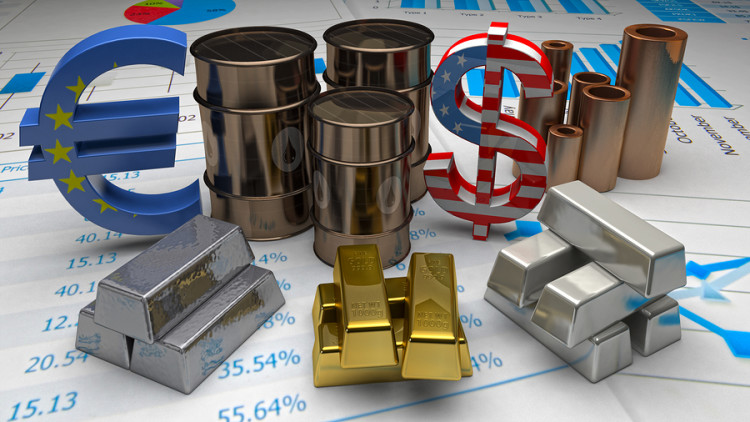Commodities Roiled as Arctic Blast Takes Hold: The Daily Prophet

published Jan 2, 2018 3:30:09 PM, by Robert Burgess
(Bloomberg Prophets) —
The bitter cold gripping much of North America may be making living conditions a bit uncomfortable, but for commodities traders it’s a chance to profit. The Bloomberg Commodity Index has risen for 13 straight days, closing Tuesday at its highest level since last February on gains in energy and certain agricultural goods. Prices for the heating fuel rose to the highest in a month as the U.S. burned the most natural gas ever on Monday, breaking a record set during the so-called polar vortex that blanketed the nation’s eastern half with arctic air in 2014, Bloomberg News reports. America consumed 143 billion cubic feet of gas as temperatures dipped to all-time lows on New Year’s Day, topping the previous high of 142 billion from four years ago, data from PointLogic Energy show. Ice in the Hudson River delayed fuel-barge deliveries, as the government warned of a home heating-fuel shortage from the East Coast to Texas. Natural gas prices have jumped 19 percent from a 10-month low on Dec. 21. U.S. retail diesel prices averaged $2.87 a gallon on New Year’s Day, the most since June 2015, according to AAA.
Beyond the energy sector, the cold weather is having an impact on wheat plants and cattle, according to Bloomberg News. March futures tracking both hard red winter wheat and soft red winter wheat climbed to the highest since early December in Chicago, while feeder-cattle futures rose as much as 4.5 cents, the exchange limit. Temperatures through Jan. 4 are forecast at 15 to 25 degrees below normal from the Southern Plains to Ohio Valley, according to the National Weather Service. The chill can also slow grain movement as ice builds on rivers and railways.
EQUITIES PICK UP WHERE THEY LEFT OFF
Stocks kicked off 2018 on a positive note, as U.S. equities led the MSCI All-Country World Index to its best start since 2013. To the bears, every move higher only serves to underscore a growing divergence between stocks and sentiment. State Street Global Markets’ index of institutional investor confidence, which differs from survey-based measures in that it is based on the actual trades, as opposed to opinions, fell for a fifth straight month in December, the firm said last week. What’s jarring is how the measure has fallen as the MSCI index of stocks has soared, after largely moving in line with the benchmark in the first half of 2017. The latest reading of 94.8 puts State Street’s the index further below 100, which is “neutral,” or where investors are neither increasing nor decreasing their long-term allocations to risky assets. By region, sentiment fell in both North America and Asia, but rose strongly in Europe in what State Street said is a sign that that European-based investors are becoming less concerned that political risks could derail the strong economic performance in that region.
CORPORATE BOND BONANZA
Although it’s been a tough time for investors in government debt, with the Bloomberg Barclays U.S. Treasury Total Return Index essentially flat last quarter in its worst performance of the year, those who focus on corporate bonds have had a much better time. Benefiting from the broad rally for riskier assets, yields on U.S. investment-grade corporate debt have dropped to within 93 basis points of Treasuries on average, according to Bloomberg News’ Robert Elson and Molly Smith. That’s significant because spreads haven’t been this narrow since before the financial crisis. Much of the demand has come from domestic investors seeking higher-quality securities during the late stages of the credit cycle, as well as overseas investors in search of higher-yielding assets than those found in European and Asian markets. There could be more room for spreads to narrow, if history is any guide, according to Elson and Smith. High-grade spreads shrank to 76 basis points in March 2005, and tightened to 51 basis points in 1997, which was the slimmest margin since 1989.
DOLLAR’S DOLDRUMS CONTINUE
At the start of 2017, almost every currency strategist was calling for a big rally in the dollar as the Fed raised interest rates and foreign cash came flooding into the U.S. to take advantage of relatively high yields. Instead, the Bloomberg Dollar Spot Index crashed 8.52 percent. Once again, strategists are calling for a dollar rally, and once again the greenback isn’t cooperating. The Bloomberg Dollar Spot Index tumbled as much as 0.5 percent to start 2018 in its biggest decline since Dec. 13. As Bloomberg News’s Katherine Greifeld reports, the dollar is struggling as rising commodity prices reignite bets that the global reflation trade will take hold in 2018, dimming the U.S. currency’s appeal relative to those of faster-growing economies. That makes sense, as the MSCI Emerging Markets Currency Index shot up as much as 0.54 percent to its highest level since July 2014. “The backdrop for the dollar is just not very good,” Mark McCormick, Toronto Dominion Bank’s North American head of foreign-exchange strategy, told Bloomberg News.
GOLD’S ON A TEAR
The precious metal rose for the eight consecutive time on Tuesday, marking its longest rally since mid-2011, bringing its gains over the period to 4 percent. In many ways, gold’s rally, which builds upon last year’s 14 percent increase, defies conventional wisdom. With the economy gathering strength, the Fed is on track to boost rates three times this year after boosting them the same number of times in 2017. Normally, higher rates tend to make non-interest-bearing assets such as gold less attractive. “The old adage that the market can stay irrational longer than you can stay solvent appears to be alive and well in the gold market at the moment,” Jeffrey Halley, a senior market analyst at Oanda in Singapore, wrote in research note. Halley chalks up the recent gains to complacency over the trajectory of U.S. rates, according to Bloomberg News Ranjeetha Pakiam and Jasmine Ng. The median year-end gold estimate of strategists surveyed by Bloomberg is $1,255 an ounce, below the $1,316 an ounce that it traded at on Tuesday.
TEA LEAVES
It’s time to get over your New Year’s hangover, as the economic data will be coming fast and furious starting Wednesday. That’s when the Institute for Supply Management releases its monthly manufacturing report for December. The median estimate of economists surveyed by Bloomberg is for the index to remain little changed at 58.2, which is well above the average of 53.5 over the past five years. The index has been on a broad uptrend since 2016, when it started that year below 50, the dividing line between growth and contraction. The current reading is consistent with gross domestic product growth exceeding 3 percent, according to Bloomberg Economics.
This column does not necessarily reflect the opinion of the editorial board or Bloomberg LP and its owners.
To contact the author of this story: Robert Burgess at bburgess@bloomberg.net To contact the editor responsible for this story: Max Berley at mberley@bloomberg.net
footer
For more columns from Bloomberg View, visit Bloomberg view
copyright
© 2018 Bloomberg L.P




No Comment